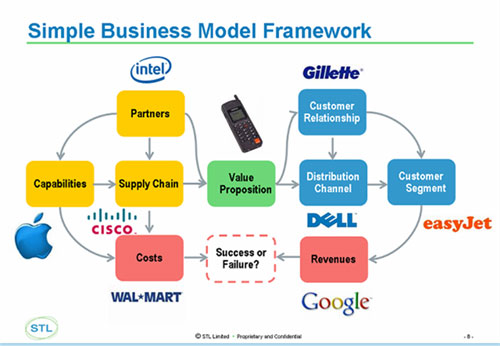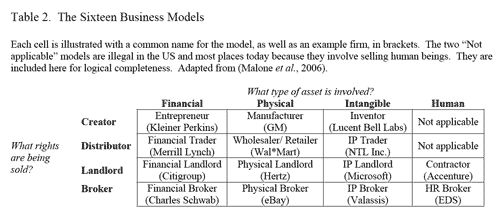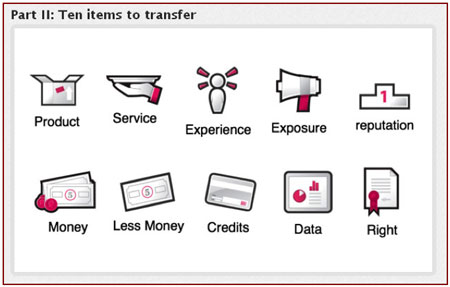About Thinking Creatively
Thinking Creatively is about taking a step back... when you want or need to think strategically and creatively about your business... or about your customer's business... or about a solution to a challenging business problem. The goal is to be one part inspiration and one part motivation. We hope to provide - over time - thought-provoking advice, tools, ideas and company profiles that help get you to your next breakthrough. Your feedback and interaction is invited, welcomed and encouraged.
Thinking Creatively is made possible by the support of GMC Software Technology. Normally such features are for "Premium Members" only. However, because the topic is so timely and essential to all executives in the industry we asked GMC Software Technology to provide support for this series. Their support allows us to to present these articles free for all WhatTheyThink.com members.
You'll find the phrase "business model" mentioned in lots of articles, cited in academic papers, obsessed over by venture capitalists and overheard in thousands of conference rooms daily. Yet, it is a concept that is often ill-defined, misunderstood, or completely ignored.
In today's edition of "Thinking Creatively", we'll go through the basics of the business model, offer some definitions and examples, and provide some tools and advice on how you can put the concept to work to make money in new ways.
Our goal is simple: to help open up your minds to think about your business in a new context, in a new framework and in a reconstituted way. Also, by looking outside the print industry, hopefully you can find clues on how to innovate inside the industry.
Definitions and Diagrams
The most basic and easiest definition was summed up in an academic article on the MIT website:
http://ccs.mit.edu/papers/pdf/wp226.pdf
We define a business model as consisting of two elements: (a) what the business does, and (b) how the business makes money doing these things.
Investopedia has a good write up that defines a business model:
http://www.investopedia.com/terms/b/businessmodel.asp
What Does Business Model Mean?
The plan implemented by a company to generate revenue and make a profit from operations. The model includes the components and functions of the business, as well as the revenues it generates and the expenses it incurs.
...the business model dates back to the earliest days of business; it merely describes the way in which a company makes money.
There are many variations in describing the components of a business model.
Here is a diagram, titled "Simple Business Model Framework" (yet it is not exactly simple). What I do like about this chart is that it shows you all the elements that go into a business model and all the "flows". It also shows you which area of the framework some famous companies have chosen to focus their attention. Dell, focuses on distribution with "The Direct Model". Intel focuses on partners, offering one central component that gets built into other devices. Wal-Mart focuses on low costs. And Apple has focused on bringing all the necessary capabilities together to create a breakthrough business model (e.g. iTunes/iPods, Apps/iPhones).

Source: http://www.telco2.net/blog/images/BusinessModelChart%20%28Small%29%20%28Custom%29.png
How do you start to think about the best type of business model for you?
There are many who have tried to define what goes into a business model and the different kinds of business models. A great paper to read – which provides a great review of the literature on business models -- was written by Dr. Susan Lambert of University of South Australia. http://www.audiencedialogue.net/documents/Businessmodels_Lambert_000.pdf
One of her main points is that there is one common theme in all business model frameworks – and that is the concept of value.
Table 1: Table of Business Model Components What is present in all business model frameworks and definitions is the concept of value.
|
Another way to view types of business models is more of an academic look. In the chart below, the authors have presented a "taxonomy" for business models. They claim 16 types of business models and show an example for each one.
To understand this chart, take a look at the two main defining dimensions. Across the top they define the type of asset being offered. Is it more financial value being offered? Or is it an actual physical product? Or, are you offering something you can't manufacture, like intellectual property or ideas? Or lastly, are you basically reselling the work of people?
On the left hand side, the question is, what rights are being sold. What role do you play with the assets? Do you create the asset? Distribute it? Rent it out? Or broker it?

http://seeit.mit.edu/Publications/DoBMsMatter7.pdf
For another view, consider this list of web-based business model types, authored by Michael Rappa, a professor at North Carolina State University. Rappa suggests nine different online business models. Do you make money through brokering, or selling the work/products of others (e.g. renting out email lists)? Do you offer free services and make money via advertising (Google search)? Are you a merchant (Amazon)? Are you a utility (e.g. offering to back up people's hard drives remotely)? Here's his list:

http://digitalenterprise.org/mrappa.html
How do you use the business model framework to reshape your business?
Before you get started, you might think of some classic commercial printing business model breakthroughs. The advent of the "quick printer" created a retail phenomenon that still exists today. The data center printer is another example that ushered in the world of electronic or digital printing. The distributed or online printer model is running strong today. Print brokers offer a different value than equipment-based printers.
And of course, one of the most oft-cited breakthroughs in the entire history of business models is the invention of Xerox, and the original 914. When it was deemed too expensive to purchase, the notion of leasing and per copy charges was invented. The company had 12 years of 41% compound annual growth. http://www.quickmba.com/entre/business-model/
What is available in your quest to innovate in the area of business models? Here are some tools to help you answer this question.
The first tool is called "Business Model Building Blocks". This is available for downloading as a PowerPoint template. Here is a snapshot of the building blocks.
http://www.boardofinnovation.com/business-model-template/


Another tool is "The Business Model Canvas", which is part of a book published using a very unique business model (it was "co-written" by 470 strategy practioners). You can download this canvas…and you can also purchase the book "Business Model Generation", to help guide you through the steps.

http://businessmodelgeneration.com/
http://www.slideshare.net/Alex.Osterwalder/business-model-canvas-poster
Another approach that is proving valuable is to create a business model instead of a business plan -- and using hypotheses to prove out your ideas. It is all described in this blog: http://www.ashmaurya.com/2010/08/businessmodelcanvas/
To make this business model exercise a bit more concrete, here is one example of a carpeting manufacturer that used a similar business model tool to transform itself. Click on the link to learn more about this case study.

http://www.executiveboard.com/2009guidance/pdf/Interface_Business_Model_Experimentation.pdf
Thinking Creatively About Business Models
To help you think a bit out of the box, here are two unique and inspiring business models examples to serve as thought starters just to get you going:
- Application-Focused Model: http://www.treering.com/. This company focuses on the school yearbook and makes the process for schools much easier and much more personalized. Their description for their business is "Yearbooks for the Internet Generation".
- Combining Design, Production and Community: http://threadless.com This amazing company asks its customers to design the products, serve as their sales force, and become their employees. Plus, they still manage to get $18-24 a piece for t-shirts!. The full story is here in an article http://mass-customization.blogs.com/mass_customization_open_i/2008/05/threadless---the-full-story-inc-magazine-feature-on-threadless.html.
Can you find a way to make a new business model work for you?
Is there an opportunity for an auction model in the print industry (where you sell your capacity to customers or other printers at whatever the market will bear)? Is there room to change the value from "pieces printed or delivered mailings" to "results and impact felt"? Maybe this would take an interesting new measurement system that shows how much more impactful a printed piece is vs. an email. Can you become a broker, and, like Progressive Insurance used to do, quote several sources for the job a customer needs to do?
Now that you are armed with definitions, constructs, some tools and examples, you are ready to embark on the mission of creating your own business model breakthrough.
















Discussion
By Alin Jacobs on Oct 01, 2010
Bob, thanks for sharing some really important information. When I started reading the article, I was thinking "Business Model Canvas," which I am currently rereading.
Thinking business models and transitioning those thoughts to paper aren't easy, but definitely necessary to a business' success.
By Bob Lieber on Oct 01, 2010
Alin, thanks for your comments. The Business Model Canvas comes up over and over again in searches on the web...and I appreciate that the authors used a unique business model to sell/distribute the book and the tool.
You also mentioned that you felt that thinking about business models was "necessary" for a business's success.
To your point, an MIT paper actually did a quantitative study to measure the impact of different business models on financial returns. Their analysis concluded that the business model was more influential than any other factor, in determining business success. Here's the link: http://ccs.mit.edu/papers/pdf/wp226.pdf
Best of luck in your transformational journey!
Discussion
Join the discussion Sign In or Become a Member, doing so is simple and free